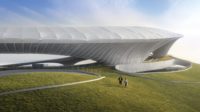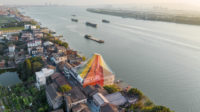MAD Architects Creates a "Station in a Forest" for a City in the Yangtze River Delta

Architects & Firms
In the past decade, China’s train stations have become a symbol of the country’s technocratic renaissance—and with president Xi Jinping’s $2.3 trillion infrastructure package, announced this past April, it’s likely that we’ll see even more of these palaces built all over the country. They are typically imposing, vast structures, with thousands of travelers rushing around. But Ma Yansong, the founder of Beijing-based MAD Architects, aimed to create a more relatable, human-scaled architecture with his firm’s design for a new station for Jiaxing, a city of 5.4 million people—one with a significant place in Chinese Communist Party (CCP) history—about 60 miles southwest of Shanghai. On the run from the police in 1921, early CCP members in Shanghai hightailed it to Jiaxing and wound up having the first party conference there, on a rented tourist boat in a lake.

1

2
The futuristic waiting rooms (1 & 2) are gleaming and white in polished engineered stone. Photos © CreatAR Images, click to enlarge.
Officially opened in time for the 100th anniversary of this meeting, MAD’s futuristic station, which serves regional commuters in the Yangtze River delta, especially those traveling to and from Shanghai or Hangzhou, replaces an aging and undersized facility. The new station, which will serve 5.3 million people each year, is largely submerged underground, with its main waiting rooms 27½ feet below an expansive green roof. By seamlessly integrating this new landscape with Jiaxing’s existing People’s Park, and planting 1,500 canopy trees, Ma has created an 87-acre oasis in the center of the city for what he calls a “station in a forest.”
Travelers move through tunnels, trapezoidal in section (3), to reach the platforms at ground level (4). Photos © CreatAR Images (3), ArchExist (4)

3

4
In addition to parkland, the new station development includes retail space, a globelike glass-enclosed 11-story office tower, a 100-room cylindrical hotel, as well as connections to the city’s multimodal mass transit network of buses, trams, and a subway.
A focus of this complex is a diminutive masonry building, a replica of the city’s first station, built in 1907 but destroyed in 1937 during the second Sino-Japanese War. MAD worked with heritage consultants to recreate the two-story structure—the arrival point for the CCP members a century ago. The team dug through historical archives, to match the form, size, and materials of the original building. The rebuilt station houses an exhibition devoted to the CCP’s first meeting in Jiaxing and a space for musical performances.

5
A focus of the complex is a rebuilt early 20th-century station (5), which is visible from within the new building (6). Photos © CreatAR Images (5), ACF (6)

6
In contrast to the rebuilt Victorian-style edifice, with its Flemish-bond facades in two colors of brick, MAD’s subterranean station, connected to the landscape above by sunken courtyards, is minimalist and gleaming white, with floors and walls in polished engineered stone (a material that is durable and easy to clean) and with honeycomb aluminum ceiling panels (to absorb sound). Its pair of waiting rooms—one to the south of the train platforms and one to the north—are capacious, each nearly 400 feet long, more than 80 feet wide, and the equivalent of several stories tall. But, despite the rooms’ scale, features such as the ample daylight pouring in through ground-level glazing and skylights, as well as indoor plantings, create a gracious and comfortable atmosphere. From the level of the park, the waiting rooms’ gently curved “floating“ roofs—supported by steel trusses and covered in photovoltaic panels—project just one story above the landscape, so as not to overwhelm the recreated historic station.

Sunken courtyards connect the concourse levels with the parkland above. Photo © ACF
Ma considers the complex a living tribute to CCP history as well as a state-of-the-art, functioning station. About Jiaxing, Ma says, “The city’s memory deserves to be respected, as do its hopes for the future.” His station’s airy humanist architecture, integrated into nature, does just that, articulating a vision that celebrates the past, but also looks forward.
Click plans to enlarge

Click section to enlarge

Credits
Architect:
MAD Architects
www.i-mad.com
Personnel in architect's firm who should receive special credit:
Ma Yansong, Dang Qun, Yosuke Hayano, Liu Huiying, Tiffany Dalhen, Yao Ran, Yu Lin, Cao Chen, Chen Nianhai, Cheng Xiangju, Reinier Simons, Fu Xiaoyi, Shang Li, Chen Wei, He Shunpeng, Li Zhengdong, Cao Xi, Zhang Kai, Li Xinyun, Kaushik Raghuraman, Deng Wei, Huang Zhiyu, Huai Wei, Sun Mingze, Dayie Wu, Hou Jinghui, Yin Jianfeng, Claudia Hertrich, Liu Zifan, Xie Qilin, Alan Rodriguez Carrillo, Qiang Siyang
Architect of Record:
Tongji Architectural Design (Group) Co., Ltd., China Railway Siyuan Survey and Design Group Co., Ltd.
Interior Designer:
Shanghai Xian Dai Architectural Decoration & Landscape Design Research Institute Co., Ltd.
Engineers:
Structural: LERA Consulting Structural Engineers
Consultants:
Heritage: Shanghai Shuishi Architectural Design & Planning Corp.,Ltd
Façade: RFR Shanghai
Landscape: Z’scape Landscape Planning and Design
Lighting: Beijing Sign Lighting Industry Group
Signage: NDC CHINA, Inc.
General Contractor:
China Railway Construction Engineering Group, China Tiesiju Civil Engineering Group, China Construction Eighth Engineering Division Co., Ltd.
Photographer:
ACF
Specifications
Aluminum Honeycomb Panel:
Jiangsu Compodan Metal Technology Co., Ltd.
Changzhou Evergreen Composite Co., Ltd.
Inorganic Artificial Marble:
Dongguan Universal Classical Material Ltd.
Shanghai Chuoqi Group
Photovoltaic Solar Panel:
Advanced Solar Power (Hangzhou) Inc.
Concrete:
Dagu Concrete
Ultra High Performance Concrete:
BO CHUANG DA (Shanghai) New Material Technology Co., Ltd.
Jiangsu FORM New Material Technology Co., Ltd.
Glass:
Tianjin Xinbao Glass Co., Ltd.






